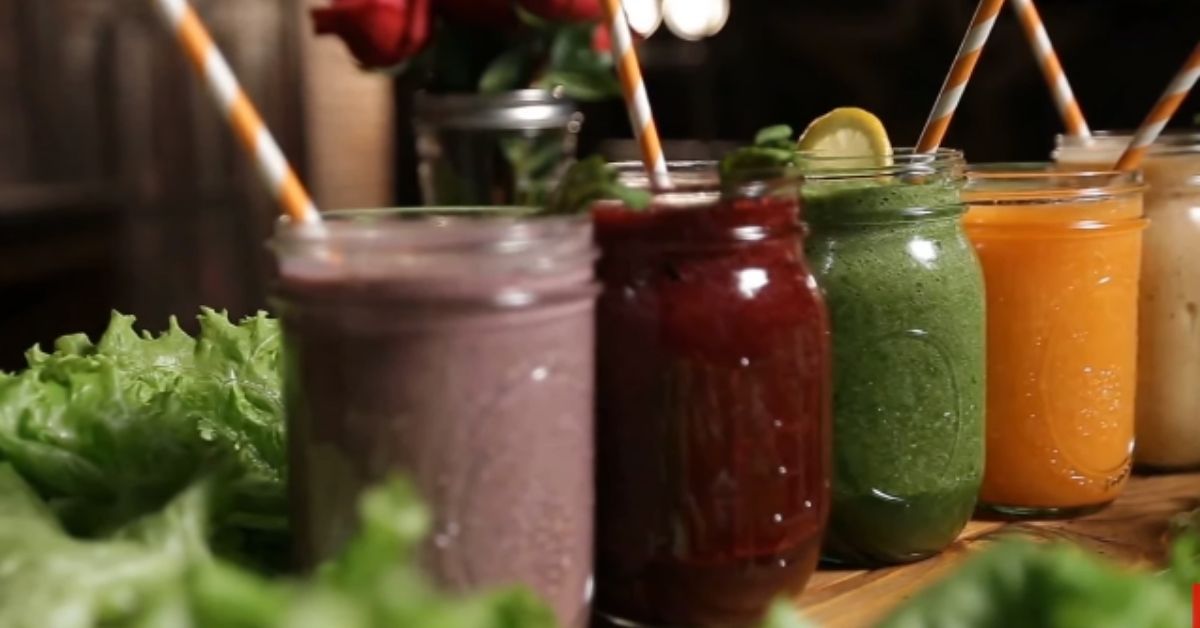Imagine starting your day with a refreshing glass of juice that not only tantalizes your taste buds but also helps manage your cholesterol levels. Intriguing, isn’t it? Juicing is a splendid way to incorporate more fruits and vegetables into your diet, and certain combinations can particularly target cholesterol, enhancing your heart health.
This homemade juice recipe is crafted with ingredients known for their cholesterol-lowering properties. It’s a simple, tasty solution to complement your health-focused lifestyle. Whether you’re looking to shake up your morning routine or add a nutritious boost to your diet, this juice fits perfectly into your daily regimen, offering both flavor and health benefits.
Ingredients
Crafting this cholesterol-lowering juice involves using specific fruits and supplements known for their health benefits. Ensure all components are fresh and organic for optimal results.
Fruit Selection
- Apples: 2 large apples, cored and sliced. Apples contain pectin, a type of soluble fiber that helps reduce cholesterol levels.
- Oranges: 2 large oranges, peeled and segmented. Oranges are rich in vitamin C and flavonoids which aid in lowering bad cholesterol (LDL).
- Grapes: 1 cup of red grapes. Including grapes in your diet can improve heart health due to their high antioxidant content.
- Lemons: Juice of 1 lemon. Lemon juice enhances flavor and has been shown to improve lipid profiles.
- Flaxseeds: 1 tablespoon of ground flaxseeds. These seeds are a powerhouse of omega-3 fatty acids and fiber that help in lowering cholesterol.
- Chia Seeds: 1 tablespoon. Chia seeds are another excellent source of omega-3 fatty acids and can help reduce LDL cholesterol levels and increase HDL cholesterol levels.
- Turmeric: 1/2 teaspoon. Turmeric contains curcumin, which is known for its anti-inflammatory properties and ability to reduce cholesterol absorption in the gut.
- Ginger: 1 inch of fresh ginger, peeled and minced. Ginger helps in boosting metabolism and improving the cardiovascular system by lowering blood cholesterol levels.
Equipment Needed
To create this heart-healthy homemade juice, you will need a few key pieces of equipment. Ensuring you have the right tools can make the process of juicing easier and more effective, allowing you to extract the maximum nutrients from your ingredients. Here’s what you’ll need:
- Juicer: A good-quality juicer is essential for extracting juice from fruits and vegetables effectively. Opt for a masticating juicer if possible, as it helps preserve the nutrients of the ingredients by processing them slowly.
- Sharp Knife: A sharp knife is needed to properly chop the fruits and vegetables before juicing. This makes the juicing process smoother and more efficient.
- Cutting Board: Use a large, sturdy cutting board for prepping your ingredients.
- Measuring Cups and Spoons: To ensure you follow the recipe accurately, have a set of measuring cups and spoons handy. Precise measurements help maintain the nutritional benefits of your juice.
- Strainer: Depending on your juicer and personal preference, you may want a strainer to remove any excess pulp or foam from the juice before drinking.
- Large Mixing Bowl: If your juicer expels ingredients into a built-in container, a large bowl may not be necessary. However, if not, a large bowl will help catch the juice as it comes out of the juicer.
- Storage Containers or Bottles: Have airtight containers or bottles on hand if you plan to store any leftover juice. It’s best to consume the juice fresh but if storing, make sure the containers are clean and airtight to preserve the quality and nutrients of the juice.
Each piece of equipment plays a crucial role in the creation of your cholesterol-lowering juice, ensuring that each sip is as nutritious as possible.
Preparation
Proper preparation is crucial to ensure your juice retains the maximum nutritional benefits. Here’s how to prepare the ingredients for your cholesterol-lowering juice.
Washing and Cutting
- Begin by thoroughly washing all fresh produce under cold running water. This step is essential to remove any pesticides or contaminants.
- For leafy greens like spinach or kale, immerzing them in a bowl of cold water can help loosen any residual dirt. Swish them around gently, then rinse under cold water.
- Using a sharp knife, cut the fruits and vegetables into sizes that will easily fit your juicer’s feed chute. For instance, apples and beets should be quartered, and celery stalks should be cut into thirds. This ensures even and efficient juicing.
- Remove any pits from fruits such as peaches or plums, as these can damage your juicer.
- If you are adding powdery supplements like whey protein or ground flaxseeds, measure the required amount indicated in the recipe. Usually, a tablespoon is sufficient for a single batch of juice.
- For oil-based supplements like fish oil or flaxseed oil, use a measuring spoon to add the correct dosage directly into the juice after extraction.
- Stir any supplements thoroughly into the juice until completely dissolved to ensure they are evenly distributed throughout your drink. This step is important for achieving the full health benefits of the supplements.
Directions
Now that you’ve prepared your ingredients and are familiar with your equipment, let’s dive into the juicing and enhance your juice with beneficial supplements.
Juicing Process
- Begin with washing your juicer and any containers you will use to collect the juice. Ensure they are completely clean to avoid any contamination.
- Start by juicing the softer fruits and vegetables like oranges and tomatoes. These items don’t require much force and will easily release their juices.
- Next, add harder ingredients such as carrots and beets. It’s essential to juice these at a steady pace, pushing them gently into the juicer to prevent the machine from jamming.
- Following the hard vegetables, juice leafy greens such as spinach and kale. These can be rolled up into balls or folded to compact them for better extraction.
- Once all the produce has been juiced, stir the mixture thoroughly. This ensures a uniform flavor and consistency in your juice.
- After juicing, it’s time to enhance your drink with cholesterol-lowering supplements like ground flaxseeds or whey protein. Measure out the recommended amount, typically one tablespoon of flaxseeds or one scoop of whey protein.
- Slowly sprinkle your chosen supplement over the juice while stirring continuously. This will help evenly distribute the supplement without clumping.
- Continue to stir for an additional minute to ensure that the supplements are fully integrated into the juice.
- Taste your juice and adjust the supplements if needed. Depending on your preference, you might want to add more for flavor or nutritional benefits.
- Once satisfied with the taste and consistency, pour the juice into a glass and enjoy immediately to benefit from the maximum nutrients and freshness.
By following these steps, you ensure that your cholesterol-lowering homemade juice is not only nutritious but also delicious and full of heart-healthy benefits.
Serving Suggestions
After mastering the art of juicing for cholesterol management, you might wonder how best to enjoy your freshly made concoction. Here are some serving suggestions that will help you incorporate this healthy juice into your daily routine seamlessly and delightfully.
Optimal Consumption Time
To maximize the cholesterol-lowering benefits, drink your homemade juice early in the morning on an empty stomach. This allows your body to absorb the nutrients more effectively without the interference of other foods. Alternatively, you can enjoy a glass of your juice 30 minutes before each meal to aid in digestion and boost nutrient uptake.
Complementing Meals
Pair your juice with a balanced breakfast that includes whole grains and lean proteins. This combination ensures a steady release of energy throughout the morning while stabilizing your blood sugar levels. For a heart-healthy breakfast, consider a bowl of oatmeal topped with nuts and a side of your nutritious juice.
Refreshing Coolers
Transform your juice into a refreshing drink on warmer days by adding ice cubes or mixing it with sparkling water for a fizzy twist. This not only cools you down but also makes your juice intake more enjoyable, encouraging you to drink more fluids throughout the day.
Pre-Workout Boost
Take advantage of the natural sugars and vitamins in your juice by consuming it 30 minutes before your workout. The quick-digesting carbohydrates will provide an immediate energy boost, enhancing your performance and endurance during exercise.
By incorporating these serving suggestions, you ensure not only are you taking steps towards lowering your cholesterol, but you are also enriching your daily diet with delightful and healthful habits.
Storage Tips
Optimal Refrigeration Practices
To ensure your homemade juice retains its cholesterol-lowering benefits and fresh taste, refrigeration is key. Always store your juice in a tightly sealed glass container to minimize oxygen exposure, which can degrade nutrients. Ideally, consume your juice within 24 to 36 hours of making it. Keep the container in the coldest part of your fridge, typically at the back, away from the door.
Freezing for Extended Shelf-Life
If you can’t consume all your freshly made juice right away, freezing is a viable option to consider. Pour the juice into an airtight, freezer-safe container or heavy-duty freezer bags. Leave about an inch of space at the top as the juice will expand when frozen. Label each container with the date of freezing; properly stored, the juice can be kept for up to three months. To use, thaw the juice overnight in your refrigerator.
Keeping Ingredients Fresh
Preparation extends beyond juicing—keeping your raw ingredients fresh is just as crucial. Store ingredients like apples, beets, and carrots in your refrigerator’s crisper to maintain their freshness and nutrient content longer. For leafy greens, wrap them in a moist paper towel and place them in a produce bag before refrigerating to keep them crisp and invigorating.
By following these storage tips, you can maintain the high quality and health benefits of your heart-healthy homemade juice, making it a reliable component of your dietary regimen to help manage cholesterol levels.
Conclusion
Embracing the practice of juicing can be a transformative step toward better heart health and lower cholesterol. By integrating the strategies discussed, you’ll ensure that every glass of juice packs the most potent nutritional punch. Remember, consistency is key in reaping the full benefits of your homemade concoctions. So keep your juicer handy, your produce fresh, and your fridge well-organized. Here’s to your health and a heartier lifestyle!
Related Posts:
- Natural vs Refined Sugar: Health, Environmental, and Economic Impacts
- Pasteurized vs Unpasteurized Juice: A Comprehensive Guide to Safety and Nutrition
- Managing IBS Symptoms: Effective Carbohydrate Choices and Tips
- Ketogenic Juicing Guide: Low-Carb Recipes & Essential Tips
- Top Homemade Juice Recipes to Lower Cholesterol & Boost Heart Health
- Stomale-Friendly Meals: Top Recipes & Tips for Stomach Ulcer Relief
- Ultimate Brain Detox Juice Recipe for Enhanced Cognitive Health
- Lung Juice: Boost Your Respiratory Health with This Ginger-Lemon-Honey Beverage
- Quick Turmeric Juice Recipe for Inflammation Relief & Health
- Top Juices for Inflammation Relief: Tips and Recipes


